GCSE Religious Studies TGAU Astudiaethau Crefyddol






Study the images throughout this activity.
Some of the questions have been completed already. Answer the rest of the questions giving as much detail as possible.
Use specialist language and include relevant sources of wisdom.
Astudiwch y lluniau yn y gweithgaredd hwn.
Mae rhai o'r cwestiynau wedi cael eu cwblhau'n barod. Atebwch weddill y cwestiynau, gan roi cymaint o fanylion â phosibl.
Defnyddiwch iaith arbenigol a cheisiwch gynnwys ffynonellau doethineb perthnasol.
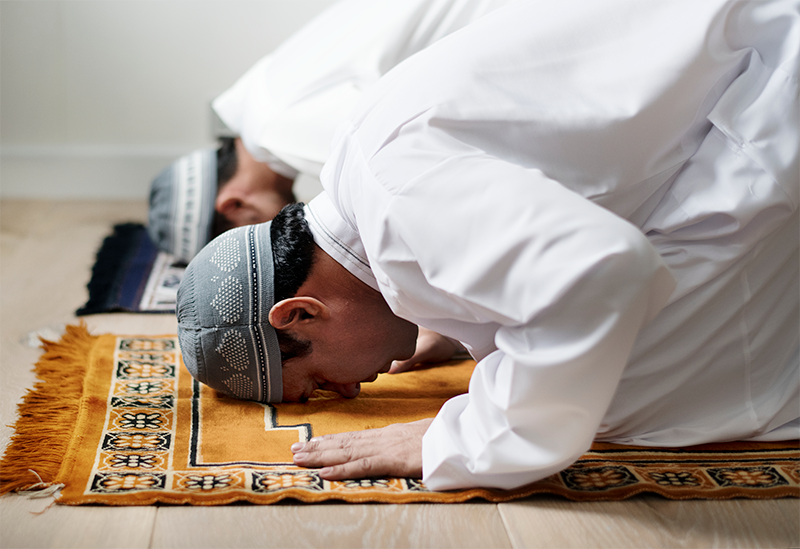
Muslims.
Mwslimiaid.
Praying (Salah in Arabic).
Important duty – one of the Five Pillars of Islam. Shows submission to the will of Allah. It also shows solidarity and equality within the Ummah. The Qur’an refers to salat as an important practice.
Gweddïo (Salah yn Arabeg).
Mae’n ddyletswydd bwysig – un o Bum Piler Islam. Mae’n dangos eu bod yn ymostwng i ewyllys Allah. Hefyd, mae'n dangos solidariaeth a chydraddoldeb o fewn yr Ummah. Mae'r Qur’an yn cyfeirio at salah fel arfer bwysig.
Five times a day.
Pum gwaith y dydd.
Anywhere that is clean and faces Mecca. Sometimes a mosque, especially on a Friday for Jummah prayers.
Unrhyw le sy'n lân ac yn wynebu Mecca. Weithiau mewn mosg, yn enwedig ar ddydd Gwener ar gyfer gweddïau Jummah.
Once they are ritually cleansed, they stand together in rows, facing Mecca, to represent the Ummah (community of Muslims). Men pray separately from women to avoid distractions. If they are not in a mosque, they may use a prayer mat and even a compass to show the direction of the Ka’aba in the sacred city of Mecca. They cup their hands to their ears to listen to God. They say prayers and pronounce ‘Allahu Akbar’ (God is great). They bow down from the waist, then prostrate with their foreheads on the ground to show full submission to Allah’s will. They sit back and look over their right and left shoulders to acknowledge the good and bad angels, and then prostrate again. Finally they stand up. This is one rakat (sequence).
Ar ôl y ddefod ymolchi, byddan nhw'n sefyll gyda'i gilydd mewn rhesi, gan wynebu Mecca, i gynrychioli'r Ummah (y gymuned Fwslimaidd). Bydd y dynion yn gweddïo ar wahân i fenywod fel nad oes unrhyw beth yn tynnu eu sylw. Os nad ydyn nhw mewn mosg, byddan nhw weithiau'n defnyddio mat gweddïo a hyd yn oed gwmpawd i ddangos i ba gyfeiriad mae'r Ka'aba yn ninas sanctaidd Mecca. Maen nhw'n rhoi eu dwylo wrth eu clustiau i wrando ar Dduw. Maen nhw'n adrodd eu gweddïau ac yn dweud ‘Allahu Akbar’ (mae Duw yn wych). Maen nhw'n plygu i lawr o'u canol, yna'n penlinio a phlygu nes bod eu talcen yn cyffwrdd â'r llawr i ddangos eu bod yn ymostwng yn llwyr i ewyllys Allah. Maen nhw'n eistedd yn ôl eto ac yn edrych dros eu hysgwydd dde a chwith er mwyn cydnabod yr angylion da a drwg, ac yna'n plygu ymlaen eto. Yn olaf, maen nhw'n sefyll i fyny. Dyma un rakat (dilyniant).
Study the images throughout this activity.
Some of the questions have been completed already. Answer the rest of the questions giving as much detail as possible.
Use specialist language and include relevant sources of wisdom.
Astudiwch y lluniau yn y gweithgaredd hwn.
Mae rhai o'r cwestiynau wedi cael eu cwblhau'n barod. Atebwch weddill y cwestiynau, gan roi cymaint o fanylion â phosibl.
Defnyddiwch iaith arbenigol a cheisiwch gynnwys ffynonellau doethineb perthnasol.
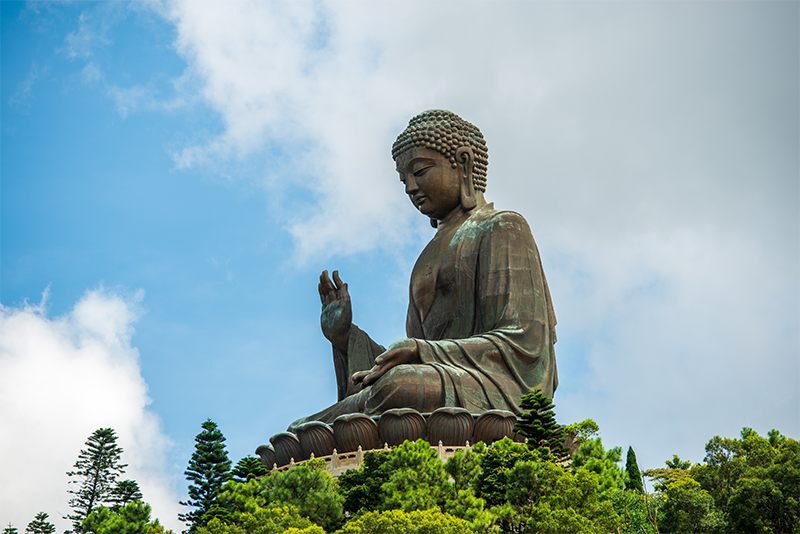
Buddhists.
Bwdhyddion.
A statue of Siddhartha Gautama (known as the Buddha).
Cerflun o Siddhartha Gautama (sef y Bwdha).
Not to worship, but to pay respect to him and to acknowledge the wisdom of his dharma (teachings).
N/A
Nid i'w addoli, ond i ddangos parch ato a chydnabod doethineb ei dharma (dysgeidiaeth).
Amherthnasol.
All over the world. Some of the largest statues in the world are of Buddhas and bodhisattvas.
Ledled y byd. Cerfluniau o Fwdhas a bodhisattvas yw rhai o gerfluniau mwyaf y byd.
Buddhists will often have statues or images of Buddha, and sometimes they will use them to meditate. In a Buddhist Temple or vihara, there will be statues and images of Buddha and/or Buddhas and Bodhisattvas, often surrounded by offerings such as food, candles, water, flowers and incense. Buddhists do not worship Buddha, but they pay him a great deal of respect because it is through his dharma, such as The Four Noble Truths, Eightfold Path and Five Precepts, and the examples he showed during his life, that the wheel of samsara can be broken and nirvana (enlightenment) can be achieved. Mahāyāna Buddhists may also pay honour and respect to other Buddhas and Bodhisattvas, and Pure Land Buddhists give special honour to Amida Buddha. Theravada Buddhists, however, consider Gautama Buddha to be the Buddha of our time and give him special status.
Yn aml, bydd gan Fwdhyddion gerfluniau neu luniau o Bwdha, ac weithiau byddan nhw'n eu defnyddio i fyfyrio. Mewn Teml Fwdhaidd, neu vihara, bydd cerfluniau a delweddau o Bwdha a/neu Fwdhas a Bodhisattvas eraill, a bydd y rhain wedi'u hamgylchynu'n aml gan bethau fel bwyd, canhwyllau, dŵr, blodau ac arogldarth. Nid yw Bwdhyddion yn addoli Bwdha, ond maen nhw'n dangos parch mawr tuag ato am mai drwy ei dharma ef, fel y Pedwar Gwirionedd Nobl, y Llwybr Wythblyg a'r Pum Argymhelliad, a'r esiampl a ddangosodd yn ystod ei oes, y gallan nhw dorri cylch samsara a chyrraedd nirvana (goleuedigaeth). Gall Bwdhyddion Mahāyāna dalu gwrogaeth a dangos parch i Fwdhas a Bodhisattvas eraill, ac mae Bwdhyddion y Wlad Bur yn talu gwrogaeth arbennig i'r Bwdha Amida. Mae Bwdhyddion Theravada, ar y llaw arall, yn credu mai'r Buddha Gautama yw Bwdha ein hoes ni ac yn rhoi statws arbennig iddo.
Study the images throughout this activity.
Some of the questions have been completed already. Answer the rest of the questions giving as much detail as possible.
Use specialist language and include relevant sources of wisdom.
Astudiwch y lluniau yn y gweithgaredd hwn.
Mae rhai o'r cwestiynau wedi cael eu cwblhau'n barod. Atebwch weddill y cwestiynau, gan roi cymaint o fanylion â phosibl.
Defnyddiwch iaith arbenigol a cheisiwch gynnwys ffynonellau doethineb perthnasol.
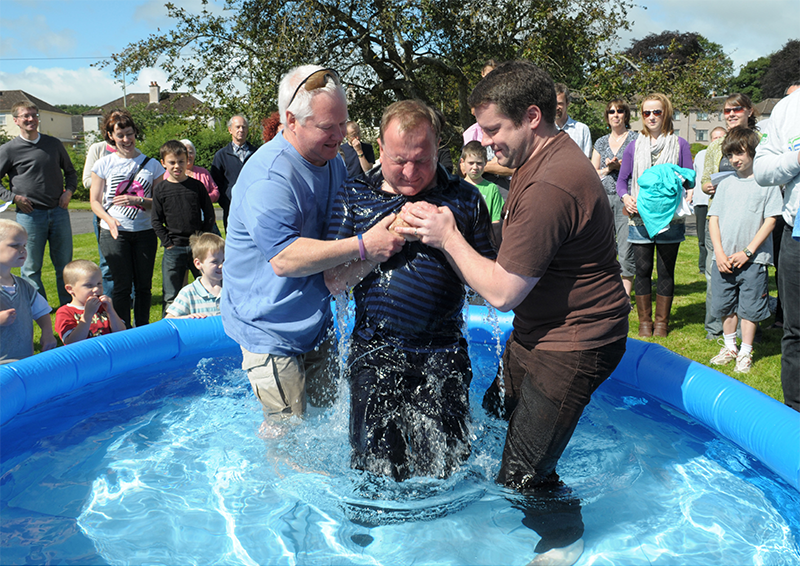
Some Christians (e.g. Baptists).
Adult or believer’s baptism or baptism by immersion.
Rhai Cristnogion (e.e. Bedyddwyr).
Oedolyn neu grediniwr yn cael bedydd neu fedydd drwy drochi.
Baptism is considered very important by Christians. Some consider it a sacrament (an outward display of inward grace). Jesus himself was baptised by John the Baptist in the River Jordan and Christians consider that event to be a symbol of the Trinity; one God as three persons – the Father, the Son and the Holy Spirit, because at Jesus’ baptism (the Son), a dove was sent (the Holy Spirit) and a voice from heaven was heard saying, “This is my Son in whom I am well pleased.” (The Father). The baptism also marked the start of Jesus’ ministry. The early Christians used baptism as an inititation ceremony into their communities because on leaving this world, Jesus instructed his Disciples to “Go and make Disciples of all nations and baptise them in the name of the Father, the Son and the Holy Spirit.” Some Christians believe it is important to baptise babies because they want to get rid of original sin quickly, but Baptist Christians believe that you should be of an age to make that commitment and declaration of faith yourself and so they always baptise adults/believers.
Mae bedyddio yn bwysig iawn i Gristnogion. Mae rhai ohonyn nhw'n ystyried ei fod yn sacrament (arwydd allanol o ras mewnol). Cafodd Iesu ei hun ei fedyddio gan Ioan Fedyddiwr yn Afon Iorddonen ac mae Cristnogion ystyried y digwyddiad hwnnw'n symbol o'r Drindod; un Duw fel tri pherson – y Tad, y Mab a'r Ysbryd Glân, oherwydd yn ystod bedydd Iesu (y Mab), cafodd colomen (yr Ysbryd Glân) ei hanfon a chafodd llais o'r nef ei glywed yn dweud, “Hwn ydy fy Mab annwyl i; mae wedi fy mhlesio i'n llwyr.” (Y Tad). Y bedydd hefyd oedd dechrau gweinidogaeth yr Iesu. Roedd y Cristnogion cynnar yn defnyddio bedydd fel seremoni i dderbyn pobl i'w cymunedau oherwydd wrth iddo adael y byd hwn, dywedodd Iesu wrth ei Ddisgyblion: “Felly ewch i wneud pobl o bob gwlad yn ddisgyblion i mi, a'u bedyddio nhw fel arwydd eu bod nhw wedi dod i berthynas â'r Tad, a'r Mab a'r Ysbryd Glân.” Cred rhai Cristnogion ei bod yn bwysig bedyddio babanod er mwyn cael gwared ar y Pechod Gwreiddiol yn gyflym, ond cred Bedyddwyr Cristnogol y dylech fod yn ddigon hen i wneud yr ymrwymiad a'r datganiad o ffydd yma eich hun ac felly maen nhw bob amser yn bedyddio oedolion/credinwyr.
As soon as a person feels they are ready to commit and can make a public testimony of faith in Jesus Christ.
Cyn gynted ag y bydd person yn teimlo ei fod yn barod i ymrwymo ac yn gallu gwneud datganiad cyhoeddus o ffydd yn Iesu Grist.
Specially built pools in Baptist chapels (called baptistries) or any pool or river which is deep enough to submerge a person.
Pyllau pwrpasol mewn capeli Bedyddwyr (sy'n cael eu galw'n fedyddfeydd) neu unrhyw bwll neu afon sy'n ddigon dwfn i berson fynd o dan y dŵr.
The person who is about to be baptised often wears white as a symbol of purity. They might be baptised alone or as part of a group. Each person/‘believer’ steps into the water and makes a public declaration of their Christian faith by explaining why they want to commit to living a Christian life. They are then pushed (immersed) completely under the water for a second. They are then brought back up and the Minister says prayers and reads appropriate passages from the Bible. In a baptistry or specially made pool, the believer walks out of the pool by a different set of steps to symbolise that their old life has been ‘drowned’, and they are beginning a completely fresh Christian life.
Mae'r person sydd ar fin cael ei fedyddio yn aml yn gwisgo gwyn fel symbol o burdeb. Gallan nhw gael eu bedyddio ar eu pen eu hunain neu fel rhan o grŵp. Bydd pob person/‘crediniwr’ yn camu i mewn i'r dŵr ac yn datgan ei ffydd Gristnogol yn gyhoeddus drwy egluro pam ei fod am ymrwymo i fyw bywyd Cristnogol. Yna, byddan nhw'n cael eu gwthio'n gyfan gwbl o dan y dŵr am eiliad. Wedyn, byddan nhw’n cael eu tynnu i fyny a bydd y Gweinidog yn adrodd gweddïau ac yn darllen darnau priodol o'r Beibl. Mewn bedyddfa neu bwll pwrpasol, bydd y crediniwr yn cerdded allan o'r pwll gan ddefnyddio grisiau gwahanol i ddangos bod ei hen fywyd wedi cael ei ‘foddi’ a'i fod yn dechrau bywyd Cristnogol hollol newydd.
Study the images throughout this activity.
Some of the questions have been completed already. Answer the rest of the questions giving as much detail as possible.
Use specialist language and include relevant sources of wisdom.
Astudiwch y lluniau yn y gweithgaredd hwn.
Mae rhai o'r cwestiynau wedi cael eu cwblhau'n barod. Atebwch weddill y cwestiynau, gan roi cymaint o fanylion â phosibl.
Defnyddiwch iaith arbenigol a cheisiwch gynnwys ffynonellau doethineb perthnasol.
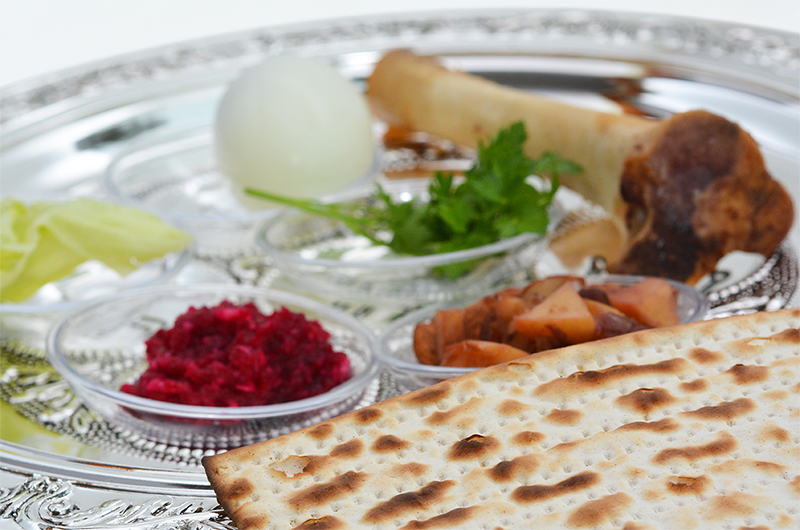
Jews.
The seder plate used during Pesach (Passover).
Iddewon.
Y plât seder sy'n cael ei ddefnyddio yn ystod Pesach (y Pasg Iddewig).
To celebrate the time, told in the Book of Exodus in the Torah, when Moses led the Israelite slaves out of slavery in Egypt, following the Ten Plagues that God caused to disrupt the lives of the Egyptians. The Book of Exodus tells Jewish people to remember this event: “This is a day you are to commemorate; for the generations to come you shall celebrate it as a festival to the LORD.” Now, it celebrates the idea of freedom more generally and it’s an opportunity for a family to come together to celebrate.
Er mwyn dathlu’r adeg y gwnaeth Moses arwain y caethweision Israelaidd allan o'u caethwasiaeth yn yr Aifft, yn dilyn y Deg Pla gan Dduw i amharu ar fywyd yr Eifftwyr, fel sy'n cael ei adrodd yn Llyfr Exodus yn y Torah. Mae Llyfr Exodus yn dweud wrth bobl Iddewig i gofio'r digwyddiad hwn: “Bydd yn ddiwrnod i'w gofio. Byddwch yn ei ddathlu bob blwyddyn drwy gadw gŵyl i'r ARGLWYDD.” Nawr, mae'n dathlu'r syniad o ryddid yn fwy cyffredinol ac mae'n gyfle i’r teulu ddod at ei gilydd i ddathlu.
Each year, in the Spring, usually around April time.
Jewish homes.
Bob blwyddyn, yn y gwanwyn, tua mis Ebrill fel arfer.
Cartrefi Iddewig.
The seder plate is full of symbolic foods. A boiled egg to celebrate new life in freedom from captivity. Charoset (a sweet paste) to remember the cement the Israelites were forced to use to build the temples and monuments for the Egyptians, and also to remember the sweetness of freedom. Bitter herbs and horseradish to remember the bitterness of slavery. Salt water to remember the tears of the Israelite slaves. A lamb bone to remember the lamb that was sacrificed in order to daub the doorposts of the Israelite homes so the Angel of Death would pass over them. Matzot to remember that the Israelites did not even have time to let their bread rise before they had to flee Egypt. Wine to celebrate. The order of service is called a Haggadah and the youngest child asks four questions during the meal in order to recall the events of the Exodus from Egypt:
The family provides an explanation for each question.
Mae'r plât seder yn llawn o fwydydd symbolaidd. Wy wedi'i ferwi i ddathlu bywyd newydd yn rhydd o gaethiwed. Charoset (past melys) i gofio'r sment y bu'n rhaid i'r Israeliaid ei ddefnyddio i adeiladu temlau a chofadeiladau i'r Eifftwyr, ac i gofio melyster rhyddid hefyd. Perlysiau chwerw a marchruddygl i gofio chwerwder caethwasiaeth. Dŵr hallt i gofio dagrau'r caethweision Israelaidd. Asgwrn oen i gofio'r oen a gafodd ei aberthu er mwyn rhoi marc coch ar ddrysau cartrefi'r Israeliaid fel y byddai Angel Angau yn mynd heibio iddyn nhw. Matzot i gofio nad oedd gan yr Israeliaid amser i adael i'w bara godi hyd yn oed cyn iddyn nhw orfod dianc o'r Aifft. Gwin i ddathlu. Enw trefn y gwasanaeth yw Haggadah ac mae'r plentyn ieuengaf yn gofyn pedwar cwestiwn yn ystod y pryd bwyd er mwyn cofio digwyddiadau'r Exodus o'r Aifft:
Mae'r teulu yn rhoi esboniad i bob cwestiwn.
Study the images throughout this activity.
Some of the questions have been completed already. Answer the rest of the questions giving as much detail as possible.
Use specialist language and include relevant sources of wisdom.
Astudiwch y lluniau yn y gweithgaredd hwn.
Mae rhai o'r cwestiynau wedi cael eu cwblhau'n barod. Atebwch weddill y cwestiynau, gan roi cymaint o fanylion â phosibl.
Defnyddiwch iaith arbenigol a cheisiwch gynnwys ffynonellau doethineb perthnasol.
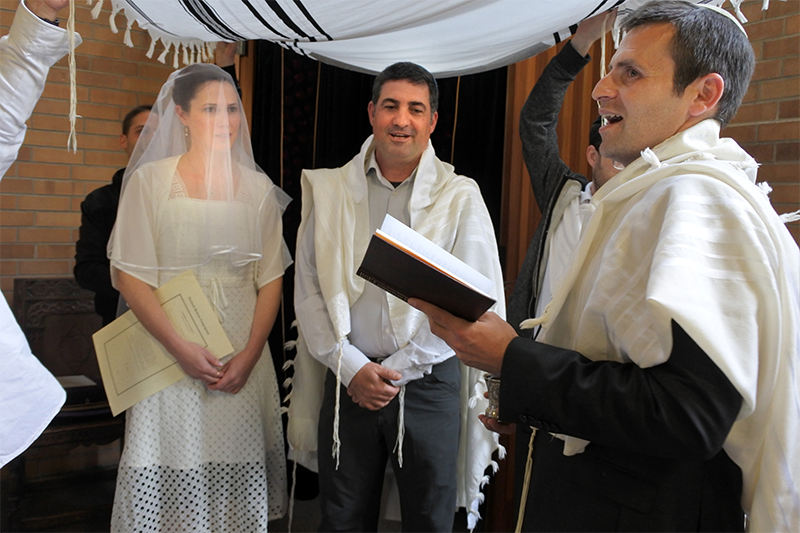
Jews.
Iddewon.
A Jewish marriage ceremony.
Seremoni briodas Iddewig.
Marriage is considered important in Judaism. The Torah says that “a man must leave his father and mother and be joined to his wife and the two should become one” and this is seen as God sanctifying marriage. Many Jewish traditions and customs and festivals, like kashrut laws, Shabbat, Sukkot and Pesach, are all celebrated in the home with family, and marriage is considered the basis of the family.
When a betrothed (engaged) couple decide to marry. Any day except Shabbat.
Mae priodas yn bwysig mewn Iddewiaeth. Mae'r Torah yn dweud: “Dyna pam mae dyn yn gadael ei dad a'i fam ac yn cael ei uno â'i wraig. Byddan nhw'n dod yn uned deuluol newydd.” Mae hyn yn cael ei weld fel Duw yn sancteiddio priodas. Mae llawer o draddodiadau ac arferion a gwyliau Iddewig, fel cyfreithiau kashrut, Shabbat, Sukkot a Pesach, yn cael eu dathlu yn y cartref gyda'r teulu, ac mae priodas yn cael ei ystyried fel sylfaen y teulu.
Pan fydd cwpwl sydd wedi dyweddïo yn penderfynu priodi. Unrhyw ddiwrnod heblaw Shabbat.
Sometimes in a synagogue, but often elsewhere and outdoors.
Weithiau mewn synagog, ond yn aml yn rhywle arall ac yn yr awyr agored.
Traditions and customs differ, but generally, once the ketubah has been signed, the ceremony can begin. The bride is the last to arrive (often accompanied by her father). She walks around the bridegroom several times; orthodox brides tend to walk around seven times. Seven is a significant number in Judaism (because, for example, God created the universe in seven days) and seven glasses of wine will also be drunk during and after the ceremony. The couple will stand underneath the chuppah. In the picture, a large tallit is being held above the couple, but the chuppah will often be a simple structure. It symbolises the home and the sides are open to symbolise welcome. The groom will often wear a tallit and a kippah, and the bride will often wear white, but it very much depends on customs and traditions. Prayers from the Torah will be said and sometimes the bride and groom’s hands will be bound together with a cord or cloth to show unity. The rabbi and/or guests will recite the seven blessings (the Sheva Brachot) and the plain ring will be placed on the index finger of the bride’s hand whilst the groom says: “Behold, you are consecrated to me with this ring according to the laws of Moses and Israel.” The Rabbi will give a speech about the importance of marriage and then blesses them. At the end, the groom (usually) will stamp on a wine glass to symbolise the destruction of the Temple in Jerusalem and also to acknowledge that marriage isn’t without difficulties. Many joke that this may be the very last time he is able to put his foot down!
Everyone will shout ‘Mazel Tov’ and the celebrations will begin at the reception.
Mae traddodiadau ac arferion yn amrywio ond, fel arfer, ar ôl i'r ketubah gael ei lofnodi, gall y seremoni ddechrau. Y briodferch yw'r olaf i gyrraedd (gyda'i thad yn aml). Mae hi'n cerdded o amgylch y priodfab sawl gwaith; mae priodferched uniongred yn tueddu i gerdded o amgylch saith gwaith. Mae saith yn rhif pwysig mewn Iddewiaeth (oherwydd, er enghraifft, creodd Duw'r bydysawd mewn saith diwrnod) a bydd saith gwydraid o win hefyd yn cael eu hyfed yn ystod ac ar ôl y seremoni. Bydd y cwpwl yn sefyll o dan y chuppah. Yn y llun, mae tallit mawr yn cael ei ddal uwchben y cwpwl, ond yn aml strwythur syml fydd y chuppah. Mae'n symboleiddio'r cartref ac mae'r ochrau ar agor i symboleiddio croeso. Bydd y priodfab yn aml yn gwisgo tallit a kippah, a bydd y briodferch yn aml yn gwisgo gwyn, ond mae'n dibynnu'n fawr ar arferion a thraddodiadau. Bydd gweddïau o'r Torah yn cael eu dweud ac weithiau bydd dwylo'r briodferch a'r priodfab yn cael eu rhwymo â'i gilydd â chortyn neu liain i ddangos undod. Bydd y rabbi a/neu'r gwesteion yn adrodd y saith bendith (y Sheva Brachot) a bydd y fodrwy blaen yn cael ei rhoi ar fynegfys y briodferch tra bod y priodfab yn dweud: “Wele, rwyt ti wedi dy gysegru i mi drwy’r fodrwy hon yn ôl defodau Moses ac Israel.” Bydd y Rabbi yn rhoi araith am bwysigrwydd priodas ac yna'n eu bendithio. Ar y diwedd, bydd y priodfab (fel arfer) yn stampio ar y gwydr gwin i symboleiddio dinistrio'r Deml yn Jerwsalem a hefyd i gydnabod nad yw priodas yn rhwydd. Mae llawer yn gwneud jôc mai dyma'r tro olaf y bydd yn gallu rhoi ei droed i lawr!
Bydd pawb yn gweiddi ‘Mazel Tov’ a bydd y dathliadau'n dechrau.
Study the images throughout this activity.
Some of the questions have been completed already. Answer the rest of the questions giving as much detail as possible.
Use specialist language and include relevant sources of wisdom.
Astudiwch y lluniau yn y gweithgaredd hwn.
Mae rhai o'r cwestiynau wedi cael eu cwblhau'n barod. Atebwch weddill y cwestiynau, gan roi cymaint o fanylion â phosibl.
Defnyddiwch iaith arbenigol a cheisiwch gynnwys ffynonellau doethineb perthnasol.
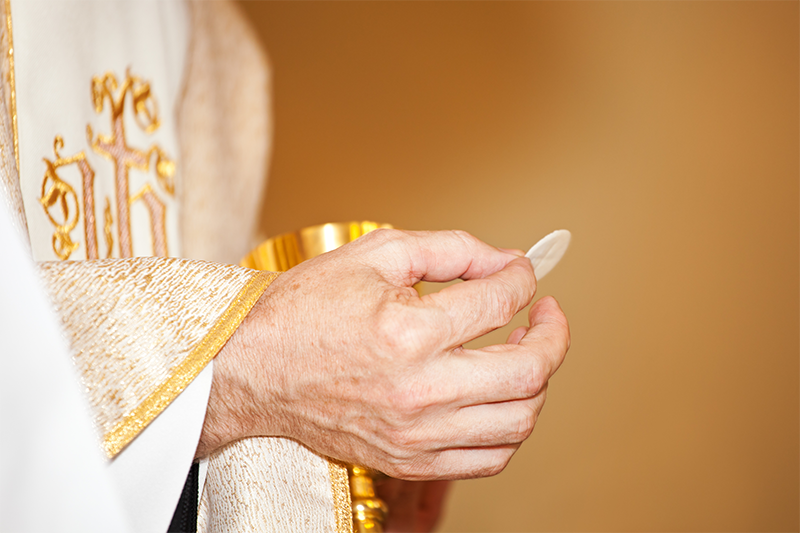
Some Christians.
Rhai Cristnogion.
Eucharist, Mass, Holy Communion, the Lord’s Supper.
Ewcharist, Offeren, Cymun Bendigaid, Swper yr Arglwydd.
At the Last Supper Jesus had with his Disciples, he broke bread and said “This is my body which will be given for you.” He also said the wine was his blood and told them to “Do this in memory of me.” Many Christians, such as Catholics and Anglicans, believe Eucharist to be a sacrament – an outward sign of inward grace. Catholics take Jesus’ words literally and think the bread and wine really do change and become Jesus’ body and blood. This is called transubstantiation. Many Anglicans see it as both literal and symbolic (that Jesus is mystically present in the bread and wine); this is known as consubstantiation. Christians such as Baptists and Methodists see it as entirely symbolic with the bread and wine there as a memorial of the Last Supper.
Yn y Swper Olaf y cafodd yr Iesu â'i Ddisgyblion, fe dorrodd Iesu fara a dweud: “Dyma fy nghorff i, sy'n cael ei roi drosoch chi.” Dywedodd hefyd mai ei waed oedd y gwin a dywedodd wrthyn nhw: “Gwnewch hyn i gofio amdana i.” Mae llawer o Gristnogion, fel Catholigion ac Anglicaniaid, yn credu bod yr Ewcharist yn sacrament – arwydd allanol o ras mewnol. Mae Catholigion yn derbyn geiriau'r Iesu yn llythrennol ac yn meddwl bod y bara a'r gwin wir yn newid ac yn dod yn gorff a gwaed yr Iesu. Yr enw ar hyn yw traws-sylweddiad. Mae llawer o Anglicaniaid yn ei weld fel rhywbeth llythrennol yn ogystal â symbolaidd (bod yr Iesu'n bresennol, mewn ffordd gyfriniol, yn y bara a'r gwin); yr enw ar hyn yw cydsylweddiad. Mae Cristnogion fel Bedyddwyr a Methodistiaid yn credu ei fod yn gwbl symbolaidd a bod y bara a'r gwin yno i'n hatgoffa ni o'r Swper Olaf.
It depends on the tradition. Catholics and Anglicans celebrate communion daily, but other Christians celebrate it less often.
At church or chapel, but it can also be taken to people’s homes and hospitals etc.
Mae'n dibynnu ar y traddodiad. Mae Catholigion ac Anglicaniaid yn dathlu'r cymun bob dydd, ond mae Cristnogion eraill yn ei ddathlu'n llai aml.
Yn yr eglwys neu'r capel, ond mae modd mynd â'r cymun i gartrefi pobl ac ysbytai hefyd.
It differs according to the Christian tradition, but in a Catholic Mass, the Eucharist is the high point of the service or liturgy. The priest will take any remaining bread from yesterday’s service from the tabernacle, symbolically wash his hands and say a prayer of thanksgiving for the bread and wine. The story of the Last Supper is then told and the bread and wine are consecrated (made holy) by holding them up to the congregation whilst saying or singing a prayer. The Lord’s Prayer is recited by everyone and the congregation offers “peace be upon you” by shaking hands with their neighbours. The congregation then files up to receive the bread (usually in the form of communion host rather than ordinary bread) from the Priest and a sip of wine from the chalice. Due to the belief in transubstantiation, nothing must be wasted, so the Priest drinks the wine that is left and any remaining hosts are placed back in the tabernacle. A final blessing is given and the Priest dismisses the congregation with “Go forth in peace to love and serve the Lord.” Other traditions have a far less formal service and use ordinary bread, and each person sips the wine from their own glass.
Mae'n amrywio yn ôl y traddodiad Cristnogol, ond mewn Offeren Gatholig, yr Ewcharist yw uchafbwynt y gwasanaeth neu'r litwrgi. Bydd yr offeiriad yn mynd ag unrhyw fara sydd ar ôl o wasanaeth y diwrnod blaenorol o'r tabernacl, yn golchi ei ddwylo'n symbolaidd ac yn adrodd gweddi o ddiolchgarwch am y bara a'r gwin. Yna, mae stori'r Swper Olaf yn cael ei hadrodd ac mae'r bara a'r gwin yn cael eu cysegru (eu gwneud yn sanctaidd) drwy eu dal i fyny i'r gynulleidfa wrth ddweud neu ganu gweddi. Mae pawb yn adrodd Gweddi'r Arglwydd ac mae aelodau'r gynulleidfa yn dweud “heddwch fo i chi” ac yn ysgwyd llaw â'u cymdogion. Yna, mae'r gynulleidfa'n ffurfio rhes i dderbyn y bara (sydd fel arfer ar ffurf ‘aberth yr offeren’ yn hytrach na bara cyffredin) gan yr Offeiriad a llymaid o win o'r cwpan cymun. O ganlyniad i'r gred mewn traws-sylweddiad, ni all unrhyw beth gael ei wastraffu, felly mae'r Offeiriad yn yfed y gwin sydd ar ôl ac mae unrhyw aberthau sydd ar ôl yn cael eu rhoi'n ôl yn y tabernacl. Mae bendith olaf yn cael ei rhoi ac mae'r Offeiriad yn rhyddhau'r gynulleidfa gan ddweud “Ewch mewn tangnefedd i garu a gwasanaethu'r Arglwydd.” Mae gan draddodiadau eraill wasanaethau llawer llai ffurfiol lle maen nhw'n defnyddio bara cyffredin, a phob person yn yfed y gwin o'i wydr ei hun.
Study the images throughout this activity.
Some of the questions have been completed already. Answer the rest of the questions giving as much detail as possible.
Use specialist language and include relevant sources of wisdom.
Astudiwch y lluniau yn y gweithgaredd hwn.
Mae rhai o'r cwestiynau wedi cael eu cwblhau'n barod. Atebwch weddill y cwestiynau, gan roi cymaint o fanylion â phosibl.
Defnyddiwch iaith arbenigol a cheisiwch gynnwys ffynonellau doethineb perthnasol.
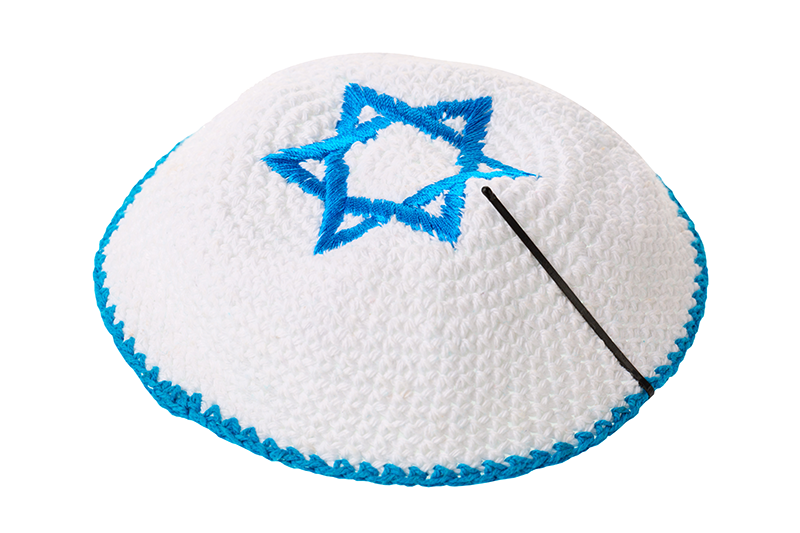
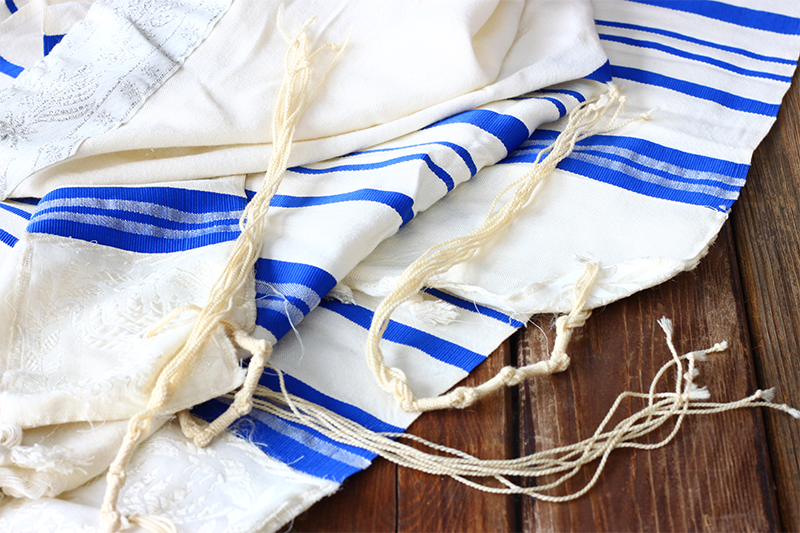
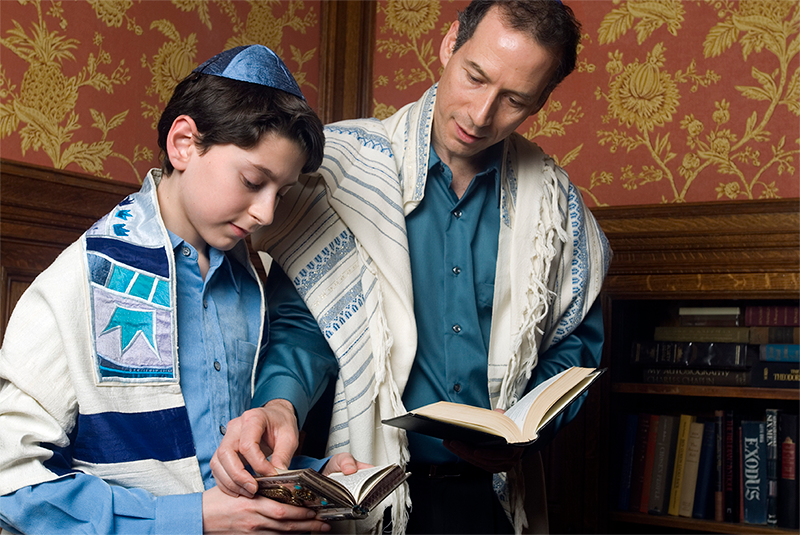
Jews.
From left to right – kippah (yarmulke), tallit and tefillin (phylacteries).
All three items of clothing give Jews a sense of identity and is an outward sign of being Jewish. They are also an important part of Jewish history and heritage. The kippah is worn to show respect and devotion to God. It separates God from humans and shows that God is above all. The Talmud teaches that a head covering should be worn, but it is not usually seen as a direct commandment in the Torah.
Iddewon.
O'r chwith i'r dde – kippah (yarmulke), tallit a tefillin (ffylacterau).
Mae'r tri dilledyn yma’n rhoi ymdeimlad o hunaniaeth i Iddewon ac maen nhw'n arwydd allanol o fod yn Iddewig. Maen nhw hefyd yn rhan bwysig o hanes a threftadaeth Iddewig. Caiff y kippah ei wisgo i ddangos parch ac ymroddiad i Dduw. Mae'n gwahanu Duw oddi wrth fodau dynol ac mae'n dangos bod Duw uwchlaw popeth. Mae'r Talmud yn dysgu y dylai gorchudd pen gael ei wisgo, ond nid yw'n cael ei weld fel gorchymyn uniongyrchol yn y Torah fel arfer.
The tallit or prayer shawl is worn by Jewish men as a reminder of the 613 mitzvot/duties in the Torah. The fringes are called tzitzit and there are 600 with each one having eight threads and five knots = 613. Traditionally, they are often blue and white as blue dye is mentioned throughout the Torah. Sometimes they have black stripes to symbolise the destruction of the Temple in Jerusalem and the exile of the Hebrew people. In the Torah, God commanded the wearing of tassles, “The Lord said to Moses as follows: Speak to the Israelite people and instruct them to make for themselves fringes on the corners of their garments throughout the ages…”
Mae dynion Iddewig yn gwisgo'r tallit neu'r siôl weddïo i'w hatgoffa o'r 613 mitzvot/dyletswydd yn y Torah. Yr enw ar y rhidens yw'r tzitzit – mae 600 ohonyn nhw ac mae gan bob un wyth edau a phum cwlwm = 613. Yn draddodiadol, maen nhw'n aml yn lliw glas a gwyn, gan fod llifyn glas yn cael ei grybwyll drwy gydol y Torah. Weithiau, mae streipiau du ynddyn nhw i symboleiddio dinistr y Deml yn Jerwsalem ac alltudiaeth yr Hebreaid. Yn y Torah, gorchmynnodd Duw y dylid gwisgo taselau, “Dyma'r ARGLWYDD yn dweud wrth Moses: "Dwed wrth bobl Israel eu bod bob amser i wneud taselau ar ymylon eu dillad…”
The tefillin consists of two leather boxes connected with a long leather strap. The boxes contain four handwritten pieces of parchment (four passages on one parchment in the hand tefillin, but four separate parchments in the head tefillin), giving the passages from the Torah that command Jews to wear these words on their arm, close to their heart and on their head, to show that God is in their heart and mind. “Tie them as symbols on your hands and bind them on your foreheads…”
Mae'r tefillin yn cynnwys dau flwch lledr sydd wedi'u cysylltu â strap ledr hir. Mae'r blychau'n cynnwys pedwar darn o femrwm â llawysgrifen arnyn nhw (pedwar darn o lawysgrifen ar un memrwn yn y tefillin llaw, ond pedwar memrwn gwahanol yn y tefillin pen), yn nodi'r darnau o'r Torah sy'n gorchymyn Iddewon i wisgo'r geiriau hyn ar eu braich, yn agos at eu calon ac ar eu pen, i ddangos bod Duw yn eu calonnau a'u meddyliau. “Rhwyma nhw ar dy freichiau i dy atgoffa di, a gwisga nhw ar dy dalcen…”
The tallit is worn whenever Jewish men (and sometimes Reform women) pray, attend the synagogue or go to a religious event or festival. However, some Reform Jews see it as optional.
Many Jews are buried in their tallit. Again, less Orthodox Jews may see the wearing of it as optional.
Mae'r tallit yn cael ei wisgo bob tro y bydd dynion Iddewig (a menywod Diwygiedig weithiau) yn gweddïo, yn mynd i'r synagog neu'n mynd i ddigwyddiad neu ŵyl grefyddol. Fodd bynnag, mae rhai Iddewon Diwygiedig yn ei ystyried fel rhywbeth dewisol.
Bydd llawer o Iddewon yn cael eu claddu yn eu tallit. Unwaith eto, bydd rhai Iddewon llai Uniongred yn teimlo fod gwisgo'r tallit yn rhywbeth dewisol.
Tefillin is worn by Orthodox Jewish men at daily morning prayers. Again, some Reform Jews may see this practice as optional.
Mae'r tefillin yn cael ei wisgo gan ddynion Iddewig Uniongred yn ystod eu gweddïau boreol dyddiol. Unwaith eto, bydd rhai Iddewon Diwygiedig yn ystyried hyn fel rhywbeth dewisol.
Anywhere, but especially when at prayer. Some groups (e.g. Orthodox) wear one at all times.
The tallit is usually worn only for prayer. Some Orthodox Jews will wear a smaller ‘tallit katan’ for daily use which can be worn easily under a shirt.
Tefillin is worn wherever morning prayers are said, which is usually at home.
Kippah: worn on the back of the head, usually held in place with a clip. Tallit: worn over the shoulders.
Unrhyw le, ond yn enwedig wrth weddïo. Mae rhai grwpiau (e.e. Iddewon Uniongred) yn gwisgo un bob amser.
Dim ond i weddïo mae'r tallit yn cael ei wisgo fel arfer. Bydd rhai Iddewon Uniongred yn gwisgo ‘tallit katan’ llai i'w ddefnyddio bob dydd, sy'n hawdd ei wisgo o dan grys.
Mae'r tefillin yn cael ei wisgo lle bynnag y caiff gweddïau boreol eu hadrodd, sef gartref fel arfer.
Kippah: mae'n cael ei wisgo ar gefn y pen, ac mae'n cael ei ddal yn ei le gan glip fel arfer. Tallit: mae'n cael ei wisgo dros yr ysgwyddau.
Tefillin is made by a specialist scribe who has to be ritually clean before he even starts to make them. They have to be completely black and completely square and the 3,188 letters on the parchment, written in Hebrew, must be written in order. If a mistake is made (even if it is the very last letter), the work has to begin again from scratch. The thread and the leather has to be from a kosher animal and it often comes with a certificate of authenticity. The tefillin is put on in a ritualistic way; arm tefillin first – on the upper part of the weakest arm – and then, once a blessing has been said, wrapped seven times towards the hand. The head tefillin is fixed where the natural hairline is and tightened once a blessing has been said. The blessing is: “Blessed are You, Lord our God, King of the universe, who has sanctified us with His commandments and commanded us to put on Tefillin.” The strap of the hand tefillin is then wound three times round the middle finger while reciting a passage from the Book of Hosea in the Torah.
Caiff y tefillin ei wneud gan ysgrifennydd arbenigol sy'n gorfod dilyn defod ymolchi cyn hyd yn oed ddechrau eu gwneud. Rhaid i'r tefillin fod yn hollol ddu ac yn hollol sgwâr a rhaid i'r 3,188 o lythrennau ar y memrwn, sydd wedi'u hysgrifennu yn Hebraeg, fod yn y drefn gywir. Os bydd camgymeriad yn cael ei wneud (hyd yn oed ar y llythyren olaf un), bydd yn rhaid dechrau'r gwaith i gyd eto. Mae'n rhaid i'r edau a'r lledr ddod o anifail kosher ac mae'n aml yn dod gyda thystysgrif dilysrwydd. Mae'r tefillin yn cael ei wisgo mewn ffordd ddefodol; caiff y tefillin ei roi ar y fraich yn gyntaf – ar ran uchaf y fraich wannaf – ac yna, ar ôl i fendith gael ei dweud, caiff ei lapio o amgylch y fraich saith gwaith tuag at y llaw. Caiff y tefillin pen ei osod ar linell naturiol y gwallt a'i dynhau ar ôl i fendith gael ei dweud. Y fendith yw: “Sanctaidd wyt Ti, ein Harglwydd Dduw, Brenin y Bydysawd, sydd wedi ein sancteiddio ni â'i orchmynion ac sydd wedi ein gorchymyn i wisgo Tefillin.” Yna, bydd strap y tefillin llaw yn cael ei rwymo deirgwaith o amgylch y bys canol wrth adrodd darn o Lyfr Hosea yn y Torah.
Study the images throughout this activity.
Some of the questions have been completed already. Answer the rest of the questions giving as much detail as possible.
Use specialist language and include relevant sources of wisdom.
Astudiwch y lluniau yn y gweithgaredd hwn.
Mae rhai o'r cwestiynau wedi cael eu cwblhau'n barod. Atebwch weddill y cwestiynau, gan roi cymaint o fanylion â phosibl.
Defnyddiwch iaith arbenigol a cheisiwch gynnwys ffynonellau doethineb perthnasol.
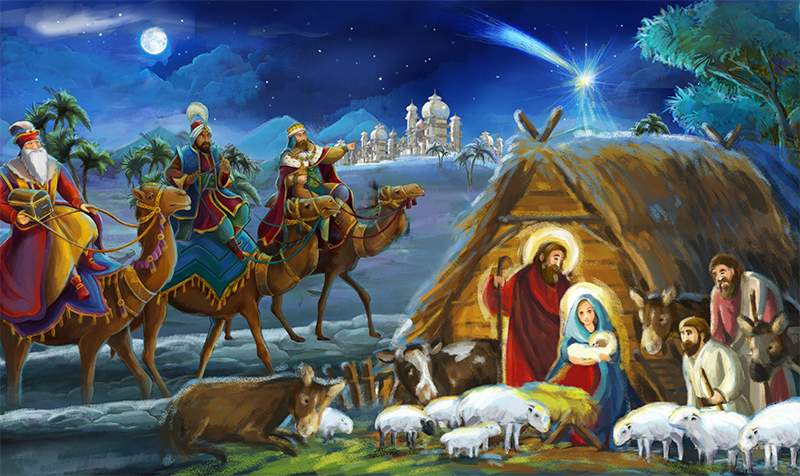
Christians.
Cristnogion.
A Nativity scene showing the birth of Jesus. Celebrated at the festival of Christmas. The picture shows a combination of the biblical Nativity stories of Matthew and Luke.
Golygfa o ŵyl y geni yn dangos genedigaeth Iesu. Caiff ei ddathlu adeg gŵyl y Nadolig. Mae'r llun yn dangos cyfuniad o’r storïau am y geni sydd yn llyfrau Matthew a Luc yn y Beibl.
For Christians, Jesus is much more than a human man. He is God Incarnate – God in flesh in the person of Jesus. The Bible says, “The Word (God) became flesh and lived among us.” He is also the second person of the Holy Trinity (Father, Son and Holy Spirit) and the Messiah foretold in the Old Testament. Jesus himself says “I and the Father are one”. His coming to Earth is to be celebrated because he brings a new Covenant (agreement between God and humankind) and a chance to atone and to heal the rift between God and humans caused by Adam and Eve in the Garden of Eden when they disobeyed God and ate the forbidden fruit. Belief in Jesus offers salvation from sin and the promise of eternal life after physical death. Jesus says, “I am the resurrection and the life, whoever believes in me even though he dies, he will live.”
I Gristnogion, mae Iesu yn llawer mwy na bod dynol. Ef yw Duw yn y Cnawd – Duw ym mherson Iesu. Mae'r Beibl yn dweud: “Daeth y Gair yn berson o gig a gwaed; daeth i fyw yn ein plith ni.” Ef hefyd yw ail berson y Drindod Sanctaidd (y Tad, y Mab a'r Ysbryd Glân) a'r Meseia a gafodd ei ddarogan yn yr Hen Destament. Mae Iesu ei hun yn dweud “Dw i a'r Tad yn un.” Mae ei ddyfodiad i'r Ddaear yn rhywbeth i'w groesawu oherwydd mae'n dod â chyfamod newydd (cytundeb rhwng Duw a'r ddynoliaeth) a chyfle i wneud iawn a chau'r hollt rhwng Duw a dynoliaeth a achoswyd gan Adda ac Efa yng Ngardd Eden pan wnaethon nhw anufuddhau Duw a bwyta'r ffrwyth gwaharddedig. Mae credu yn yr Iesu yn cynnig iachawdwriaeth rhag pechod a'r addewid o fywyd tragwyddol ar ôl marwolaeth ffisegol. Meddai Iesu, “Fi ydy'r atgyfodiad a'r bywyd. Bydd pawb sy'n credu ynof fi yn dod yn fyw, er iddyn nhw farw.”
For most Christians it is 25 December – the date was chosen because it was the date of a Roman festival of light (Saturnalia) and Jesus claimed to be “The Light of the World.” Orthodox Christians celebrate Christmas on 7 January because they use the Julian (named after Julius Caesar) and not the Gregorian calendar (named after Pope Gregory). January 7 is remembered by all Christians as the Epiphany (meaning ‘revealed’) when the Kings or Wise Men visited the infant Jesus.
I'r rhan fwyaf o Gristnogion, y dyddiad yw 25 Rhagfyr – cafodd y dyddiad ei ddewis am mai dyma ddyddiad gŵyl Rufeinig y goleuni (Saturnalia) a bod Iesu'n honni mai ef oedd “Goleuni'r Byd.” Mae Cristnogion Uniongred yn dathlu'r Nadolig ar 7 Ionawr am eu bod yn defnyddio calendr Iŵl (ar ôl Iŵl Cesar) ac nid calendr Gregori (ar ôl y Pab Gregori). Mae pob Cristion yn cofio 7 Ionawr fel yr Epiffani (sy'n golygu ‘datgelu’) pan aeth y Brenhinoedd neu'r Doethion i weld y baban Iesu.
All over the world. Christianity is the largest religion and Christians live in almost every country in the world.
Ledled y byd. Cristnogaeth yw'r grefydd fwyaf ac mae Cristnogion yn byw ym mhob gwlad yn y byd bron.
Christians prepare for the Christmas season during Advent (which means ‘coming’ in Latin). This is a season of spiritual preparation and expectation in the four weeks leading to the Incarnation at Christmas and is often remembered by the secular custom of counting down the days using an Advent calendar. Some Christians have a circular Advent wreath with five Advent candles; one is lit on each Sunday of Advent and the last is lit on Christmas day. Christmas itself has many secular customs (trees, cards, Santa etc.) but the main focus for Christians is to remember the sacred event of the Incarnation. The story of Jesus’ birth is told in plays and films, and many will start Christmas Day with a midnight service at church (often called ‘Midnight Mass’). Many will attend special carol services at church when songs such as ‘Silent Night’ will be sung. Christians will probably give cards, but they might have a more religious focus and they might give gifts as a reminder of the gifts given to the baby Jesus by the Wise Men, and also to remember the gift of God becoming human in Jesus.
Mae Cristnogion yn paratoi ar gyfer tymor y Nadolig yn ystod yr Adfent (mae 'adfent' yn golygu ‘sy'n dod’ yn Lladin). Mae hwn yn dymor o baratoadau a disgwyliadau ysbrydol yn ystod y pedair wythnos sy'n arwain at yr Ymgnawdoliad, adeg y Nadolig. Yn aml, caiff ei gofio drwy'r arfer seciwlar o gyfri'r dyddiau gyda chalendr Adfent. Mae gan rai Cristnogion dorch Adfent gron â phum cannwyll Adfent arni; caiff un gannwyll ei chynnau bob dydd Sul dros yr Adfent a chaiff y gannwyll olaf ei chynnau ar Ddydd Nadolig. Mae yna lawer o arferion seciwlar sy'n gysylltiedig â'r Nadolig (coed, cardiau, Siôn Corn ac ati), ond y prif ffocws i Gristnogion yw cofio digwyddiad sanctaidd yr Ymgnawdoliad. Bydd stori'r geni'n cael ei hadrodd mewn dramâu a ffilmiau, a bydd llawer yn dechrau Dydd Nadolig drwy fynd i wasanaeth canol nos yn yr eglwys (a gaiff ei alw'n ‘Offeren Ganol Nos’ yn aml). Bydd llawer yn mynd i wasanaethau carolau arbennig yn yr eglwys lle byddan nhw'n canu caneuon fel ‘Dawel Nos’. Bydd Cristnogion yn debygol o roi cardiau, ond efallai y byddan nhw'n gardiau mwy crefyddol eu naws ac efallai y byddan nhw'n rhoi anrhegion i gofio'r anrhegion a roddodd y Doethion i'r baban Iesu, a hefyd i gofio'r rhodd o Dduw yn cael ei ymgnawdoli yn Iesu.
Study the images throughout this activity.
Some of the questions have been completed already. Answer the rest of the questions giving as much detail as possible.
Use specialist language and include relevant sources of wisdom.
Astudiwch y lluniau yn y gweithgaredd hwn.
Mae rhai o'r cwestiynau wedi cael eu cwblhau'n barod. Atebwch weddill y cwestiynau, gan roi cymaint o fanylion â phosibl.
Defnyddiwch iaith arbenigol a cheisiwch gynnwys ffynonellau doethineb perthnasol.
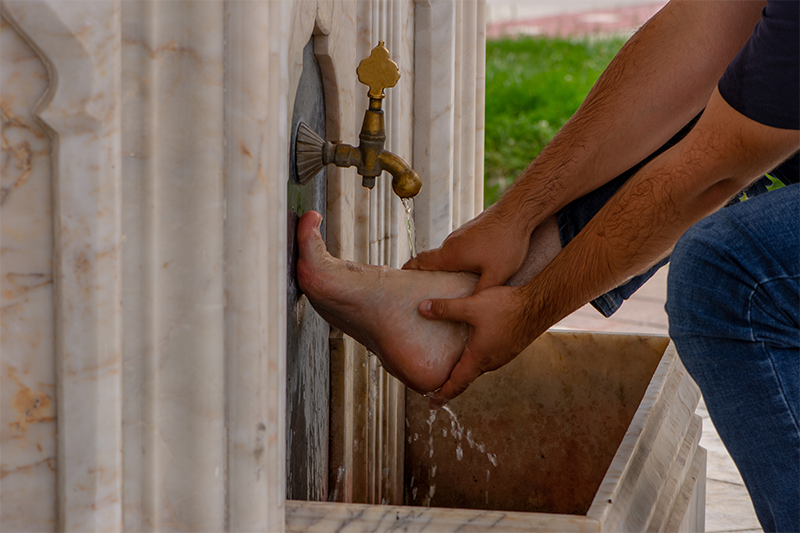
Muslims (followers of the religion of Islam).
Mwslimiaid (dilynwyr crefydd Islam).
Wudu – the practice of ritual washing.
Wudu – ymolchi defodol.
The idea of being physically AND spiritually clean before taking part in religious rituals such as praying.
Y syniad o fod yn lân yn gorfforol AC yn ysbrydol cyn cymryd rhan mewn defodau crefyddol fel gweddïo.
Before prayer (salah), so five times a day where facilities allow. Also before touching the Qur’an.
All over the world. Islam is the second largest religion and Muslims live in almost every country in the world. Most mosques will have washing facilities either indoor or outdoor.
Watch this clip as a reminder:
Cyn gweddi (salah), felly pum gwaith y dydd os oes cyfleusterau ar gael. Cyn cyffwrdd â'r Qur'an hefyd.
Ledled y byd. Islam yw'r grefydd fwyaf ond un ac mae Mwslimiaid yn byw ym mhob gwlad yn y byd bron. Bydd cyfleusterau ymolchi dan do neu awyr agored yn y rhan fwyaf o fosgiau.
Gwyliwch y clip hwn i'ch atgoffa:
Work with your classmates or your teacher to write the response.
Gweithiwch â'ch cyd-ddisgyblion neu'ch athro i ysgrifennu'r ateb.
Study the images throughout this activity.
Some of the questions have been completed already. Answer the rest of the questions giving as much detail as possible.
Use specialist language and include relevant sources of wisdom.
Astudiwch y lluniau yn y gweithgaredd hwn.
Mae rhai o'r cwestiynau wedi cael eu cwblhau'n barod. Atebwch weddill y cwestiynau, gan roi cymaint o fanylion â phosibl.
Defnyddiwch iaith arbenigol a cheisiwch gynnwys ffynonellau doethineb perthnasol.
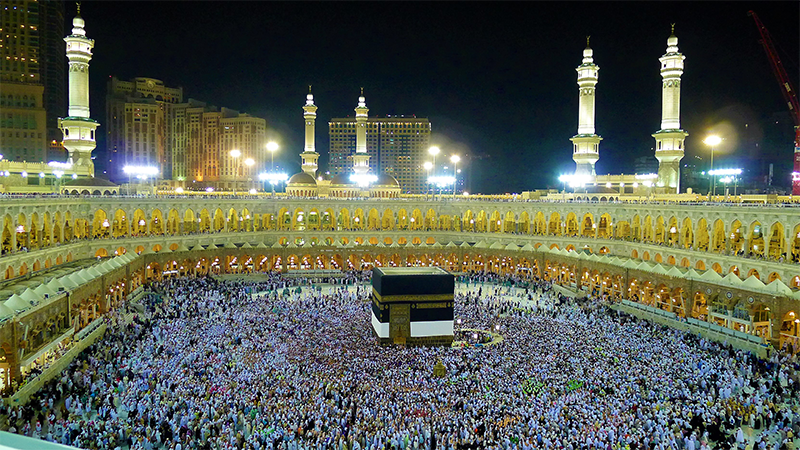
Muslims.
Mwslimiaid.
Hajj – pilgrimage.
Hajj (pererindod).
Include key language such as ‘Ummah’, ‘Duty’, ‘Pillar’, ‘Ka’aba’, ‘Abraham’, ‘Muhammed’.
Work with your classmates or your teacher to write the response.
Defnyddiwch eiriau allweddol fel ‘Ummah’, ‘Dyletswydd’, ‘Piler’, ‘Ka’aba’, ‘Abraham’, ‘Muhammad’.
Gweithiwch â'ch cyd-ddisgyblion neu'ch athro i ysgrifennu'r ateb.
Once a year.
The city of Mecca in Saudi Arabia.
Watch this clip as a reminder:
Unwaith y flwyddyn.
Dinas Mecca yn Saudi Arabia.
Gwyliwch y clip hwn i'ch atgoffa:
This shows what is was like during the COVID 19 pandemic:
Mae hwn yn dangos sut oedd pethau yn ystod pandemig COVID-19:
Gweithiwch â'ch cyd-ddisgyblion neu'ch athro i ysgrifennu'r ateb.
Work with your classmates or your teacher to write the response.
Study the images throughout this activity.
Some of the questions have been completed already. Answer the rest of the questions giving as much detail as possible.
Use specialist language and include relevant sources of wisdom.
Astudiwch y lluniau yn y gweithgaredd hwn.
Mae rhai o'r cwestiynau wedi cael eu cwblhau'n barod. Atebwch weddill y cwestiynau, gan roi cymaint o fanylion â phosibl.
Defnyddiwch iaith arbenigol a cheisiwch gynnwys ffynonellau doethineb perthnasol.
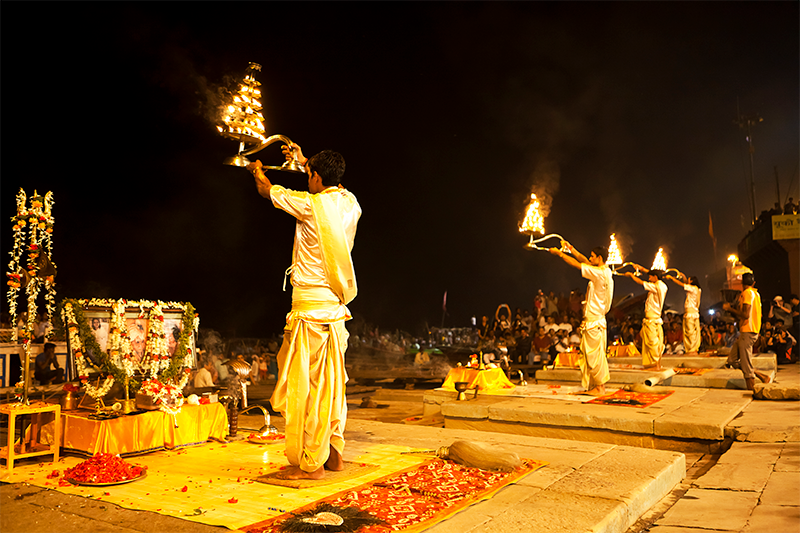
Hindus.
Hindŵiaid.
Remember to explain why the symbols are used. Use key language.
Work with your classmates or your teacher to write the response.
Cofiwch esbonio pam mae'r symbolau'n cael eu defnyddio. Defnyddiwch eirfa allweddol.
Gweithiwch â'ch cyd-ddisgyblion neu'ch athro i ysgrifennu'r ateb.
Often in a Hindu mandir, but the ceremony can take place anywhere.
All over the world.
Watch this clip as a reminder:
Caiff y seremoni ei chynnal mewn mandir Hindŵaidd yn aml, ond gall ddigwydd yn unrhyw le.
Ledled y byd.
Gwyliwch y clip hwn i'ch atgoffa:
Work with your classmates or your teacher to write the response.
Gweithiwch â'ch cyd-ddisgyblion neu'ch athro i ysgrifennu'r ateb.
Study the images throughout this activity.
Some of the questions have been completed already. Answer the rest of the questions giving as much detail as possible.
Use specialist language and include relevant sources of wisdom.
Astudiwch y lluniau yn y gweithgaredd hwn.
Mae rhai o'r cwestiynau wedi cael eu cwblhau'n barod. Atebwch weddill y cwestiynau, gan roi cymaint o fanylion â phosibl.
Defnyddiwch iaith arbenigol a cheisiwch gynnwys ffynonellau doethineb perthnasol.
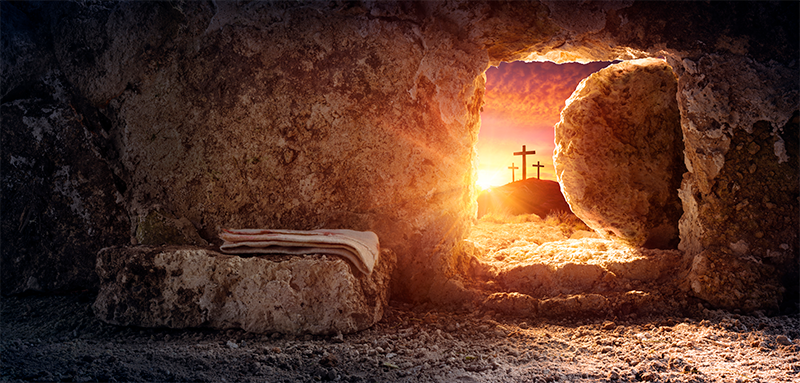
Christians.
This is the empty tomb. The resurrection of Jesus, celebrated at Easter.
Work with your classmates or your teacher to write the response.
Easter is the holiest day of the year for Christians because they believe that Jesus…
Cristnogion.
Dyma'r bedd gwag. Atgyfodiad yr Iesu, sy'n cael ei ddathlu adeg y Pasg.
Gweithiwch â'ch cyd-ddisgyblion neu'ch athro i ysgrifennu'r ateb.
Y Pasg yw diwrnod mwyaf sanctaidd y flwyddyn i Gristnogion am eu bod nhw'n credu bod Iesu…
Include key language and concepts such as ‘resurrection’, ‘life after death’, ‘sacrifice’, ‘salvation’ and use sources e.g. “I am the resurrection and the life. Anyone who believes in me, even though she/he will die, she/he will live.”
You should include a different source.
Every year at springtime (usually around March or April).
All over the world. Christianity is the largest religion and Christians live in almost every country.
Click on the link to find out how Christians celebrate Easter.
https://www.bbc.co.uk/bitesize/guides/zdcbcj6/revision/7
Work with your classmates or your teacher to write the response.
Defnyddiwch iaith a chysyniadau allweddol fel ‘atgyfodi’, ‘bywyd ar ôl marwolaeth’, ‘aberth’, ‘iachawdwriaeth’ a defnyddiwch ffynonellau e.e. “Fi ydy'r atgyfodiad a'r bywyd. Bydd pawb sy'n credu ynof fi yn dod yn fyw, er iddyn nhw farw;”
Dylech chi gynnwys eich ffynonellau eich hun.
Bob blwyddyn yn ystod y gwanwyn (tua mis Mawrth neu Ebrill fel arfer).
Ledled y byd. Cristnogaeth yw'r grefydd fwyaf ac mae Cristnogion yn byw ym mhob gwlad bron.
Cliciwch ar y linc i ddysgu sut mae Cristnogion yn dathlu’r Pasg.
https://www.bbc.co.uk/bitesize/guides/zdcbcj6/revision/7
Gweithiwch â'ch cyd-ddisgyblion neu'ch athro i ysgrifennu'r ateb.
Study the images throughout this activity.
Some of the questions have been completed already. Answer the rest of the questions giving as much detail as possible.
Use specialist language and include relevant sources of wisdom.
Astudiwch y lluniau yn y gweithgaredd hwn.
Mae rhai o'r cwestiynau wedi cael eu cwblhau'n barod. Atebwch weddill y cwestiynau, gan roi cymaint o fanylion â phosibl.
Defnyddiwch iaith arbenigol a cheisiwch gynnwys ffynonellau doethineb perthnasol.
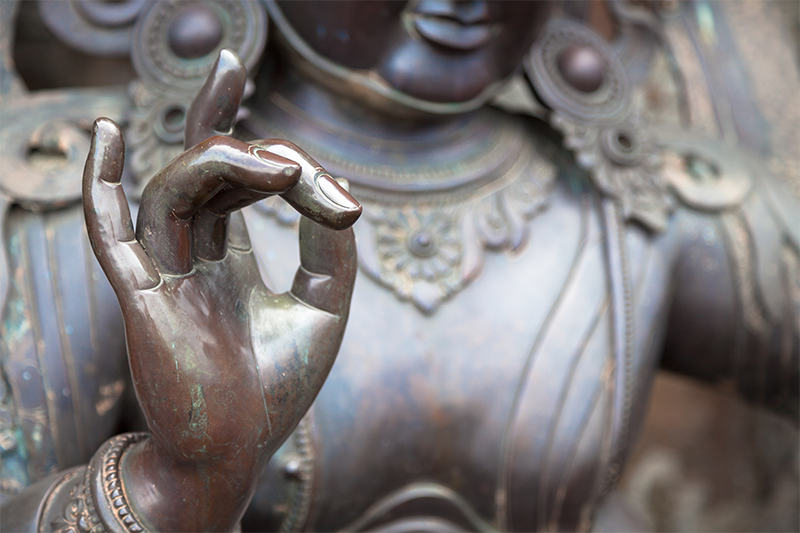
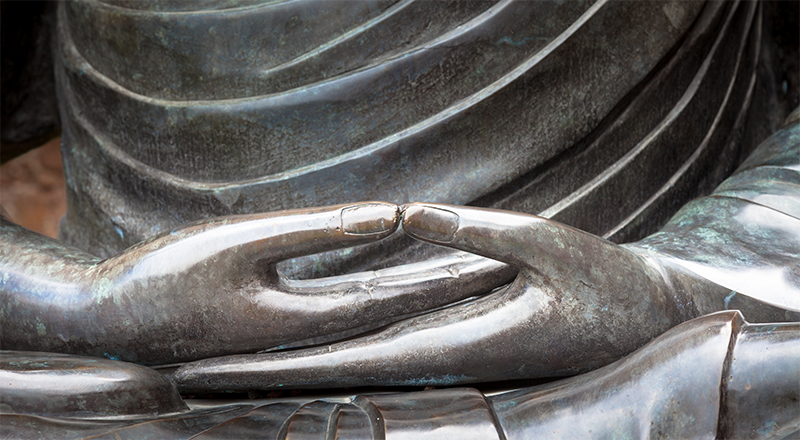
Buddhists.
Bwdhyddion.
Mudras (symbolic hand gestures) often used in meditation, yoga and religious dance.
Buddhists (and others who practice meditation and yoga) believe that the position of our hands has the ability to influence the energy of our physical, emotional and spiritual body. Mudras help to link the brain to the body, soothe pain, stimulate endorphins, change the mood and increase vitality. Across various disciplines, there are about 399 mudras, but there are some very common ones that are often seen in pictures or statues of Buddhas or bodhisattvas.
Often during the practice of meditation or yoga.
N/A
Watch this short video:
Mudras (ystumiau llaw symbolaidd) sy'n cael eu defnyddio'n aml wrth fyfyrio ac mewn ioga a dawnsiau crefyddol.
Mae Bwdhyddion (ac eraill sy'n myfyrio ac yn gwneud ioga) yn credu y gall safle ein dwylo ddylanwadu ar egni ein corff corfforol, emosiynol ac ysbrydol. Mae mudras yn helpu i gysylltu'r ymennydd â'r corff, lleddfu poen, ysgogi endorffinau, newid yr hwyliau a chynyddu bywiogrwydd. Ar draws amrywiaeth o ddisgyblaethau, mae tua 399 o mudras, ond mae rhai cyffredin iawn sy'n cael eu gweld yn aml mewn lluniau neu gerfluniau o Fwdhas neu bodhisattvas.
Yn aml wrth fyfyrio neu wneud ioga.
Amherthnasol.
Gwyliwch y fideo byr hwn:
and explain four of the mudras shown in it.
Work with your classmates or your teacher to write the response.
ac esboniwch bedwar o'r mudras sy'n cael eu dangos ynddo.
Gweithiwch â'ch cyd-ddisgyblion neu'ch athro i ysgrifennu'r ateb.